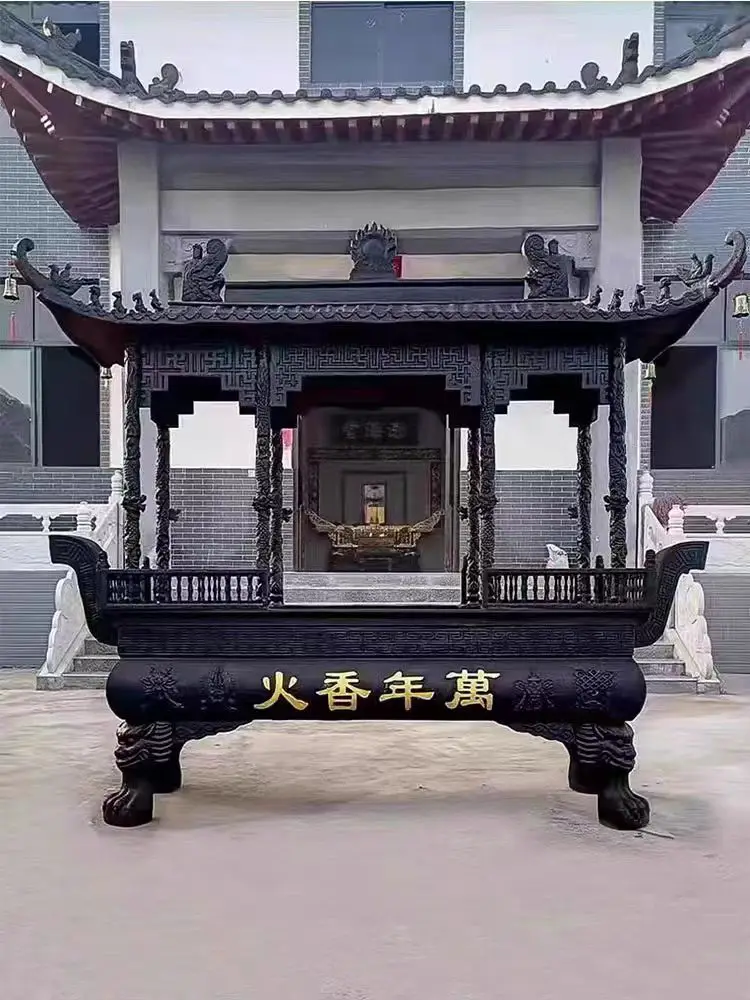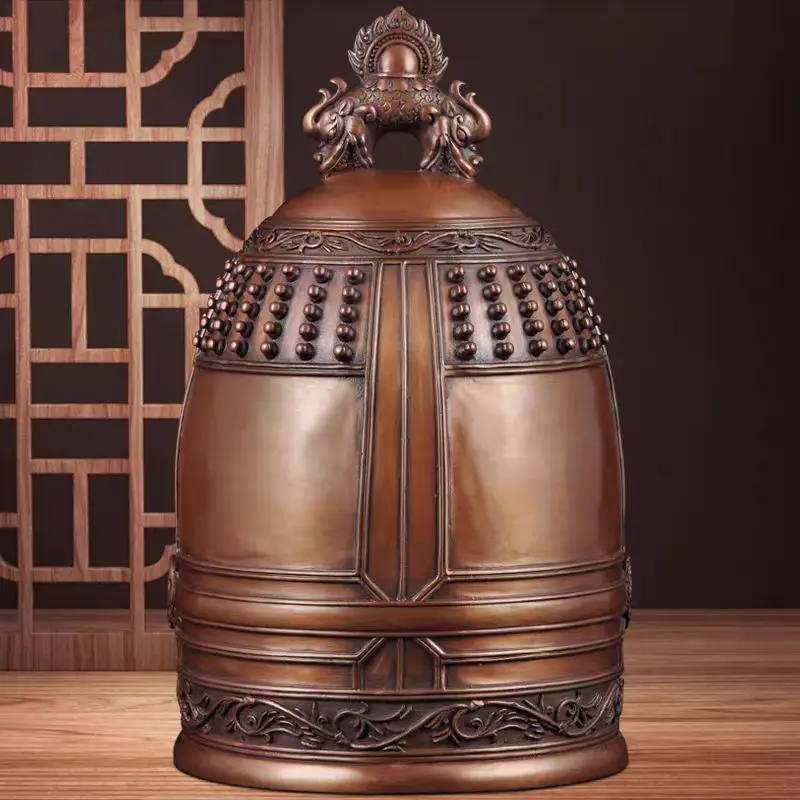
Introduction
Buddhism accessories are an indispensable part of Buddhist rituals, not only possessing unique cultural value, but also serving as a medium for transmitting wisdom, enlightenment, and tranquility. This article will provide a detailed introduction to several important Buddhist artifacts, including wooden fish, bronze bowls, incense burners, bronze bells, drums, and hand bells, exploring their origins, production techniques, symbolic meanings, and applications in Buddhist rituals.
Wooden fish

1.1 Origin and History
Wooden fish is an important percussion instrument in Buddhism accessories, and its origin can be traced back thousands of years. Originally used by Buddhist monks, it gradually spread to various parts of East Asia. Wooden Fish are usually composed of two thick wooden blocks connected to each other, resembling two fish pieces, and emit a unique crisp sound when struck.
1.2 Production process
The production of wooden fish mainly uses high-quality wood, such as camphor wood, nanmu, etc. The production process is unique, requiring careful selection of materials and exquisite carving. After completing the carving of two pieces of wood, they are connected by ropes to allow them to swing freely and produce unique melodies.
1.3 Symbolic significance
Wooden fish symbolizes alertness and enlightenment in Buddhism. Its unique voice is believed to help guide believers to focus on meditation and remind people to maintain an alert state of mind. In the daily life of monks, wooden fish is also an important auxiliary tool used to cooperate with chanting sutras and chanting Buddha.
1.4 Application scenarios
Wooden fish are mainly used in Buddhist rituals, meditation, and recitation of scriptures in sutras. The monks, while tapping on the wooden fish, cooperate with specific rhythms to help believers enter a meditative state and achieve spiritual peace and tranquility.
Singing Bowl

2.1 Origin and History
Copper bowl, also known as the Song bowl or Healing Bowls, originated in ancient India. It is a percussion instrument primarily made of copper, which produces melodious melodies by striking or rubbing the edges. Copper was initially used for yoga and meditation, and later introduced to Buddhism.
2.2 Production process
The production process of Tongluo is very unique, usually made by mixing seven different metal alloys, including brass, tin, lead, copper, etc. Exquisite craftsmanship is required during the production process, including precise hammering and special alloy proportions, to ensure that the singing bowl produces sustained and harmonious sound.
2.3 Symbolic significance
Copper is considered a magical tool that can purify the soul. Its melodious rhythm is used for meditation and practice, helping to penetrate deep into the heart and achieve peace and tranquility of the soul. In Buddhism, bronze temples are also commonly used in rituals and are seen as tools for transmitting Buddhist wisdom.
2.4 Application scenarios
Copper is widely used in Buddhist temples, meditation centers, and personal practice. In the ritual, monks or practitioners guide believers into a state of meditation by tapping or rubbing copper needles, immersing themselves in a peaceful atmosphere.
Incense burner


3.1 Origin and History
The use of incense burners in Buddhism has a long history, originating from ancient India. Originally intended to worship gods, it was gradually introduced into Buddhist rituals. The incense burner not only has a fragrant aroma, but also helps to create a solemn and solemn ceremonial atmosphere.
3.2 Production process
The production of incense burners usually uses materials such as metal, ceramics, wood, etc. Different types of incense burners have their own unique designs, some are simple and elegant, while others are exquisitely carved. The surface of the incense burner is usually designed with pores, which can allow the cigarette to naturally rise.
3.3 Symbolic significance
Incense burners are seen in Buddhism as a way of offering to the Buddha, while also representing the followers’ pursuit of purity and piety. The smoke rising from the incense burner symbolizes the fire of faith and carries a symbolic significance of transcending the world.
3.4 Application scenarios
Incense burners are widely used in Buddhist temples, Taoist temples, and personal residences. In the ceremony, believers light incense burners and express their respect for the Buddha and Buddhism through the ascent of cigarettes, creating a sacred and peaceful atmosphere.
Large buddhist temple bell


4.1 Origin and History
The bronze bell plays the role of an alarm bell in Buddhist rituals, reminding believers to be alert to their mental state. Its use can be traced back to the early period when Buddhism was introduced to China. The production and use of copper bells have become an important component of Buddhist temple rituals.
4.2 Production process
The production of copper bells requires the use of high-quality copper materials, and the production process includes casting, carving, and tuning. Copper bells of different sizes produce different tones, and the exquisite craftsmanship in the production process affects the sound quality of the copper bells.
4.3 Symbolic significance
The bronze bell symbolizes alertness and enlightenment in Buddhism. Monks use copper bells in rituals to produce a melodious and profound sound, guiding believers to maintain a meditative state and deepening their understanding of Buddhism.
4.4 Application scenarios
Copper bells are mainly used in the rituals of Buddhist temples and in the practice process of monks. In Buddhist ceremonies and solemn temple ceremonies, the melodious sound of copper bells, along with other artifacts, creates a sacred and solemn atmosphere.
Drum


5.1 Origin and History
Drums play an important role in Buddhism accessories, and their use can be traced back to ancient India. Originally used in religious ceremonies, it was later introduced to Buddhism and became an important musical accompaniment in ceremonies.
5.2 Production process
The production of Buddhist drums usually uses wood or metal, and the drum surface is made of animal leather or thin metal sheets. The carving and decoration of the drum body often have unique religious significance, reflecting the profound cultural heritage of Buddhism.
5.3 Symbolic significance
Drums are regarded in Buddhism as a tool that can awaken the soul. Its powerful and rhythmic tapping sound is believed to help break down delusions, help believers concentrate, and enter a meditative state.
5.4 Application scenarios
Drums are often used in Buddhist ceremonies, celebrations, and large-scale ceremonies in temples. Monks or musicians add solemn and melodious musical elements to the ritual by striking drums and coordinating with other magical instruments.
Hand Ringing Bell


6.1 Origin and History
Hand ringing bells are a simple and common percussion instrument in Buddhist artifacts, dating back thousands of years to ancient India. The early use of hand ringing bells was mainly used for worship and religious ceremonies.
6.2 Production process
The production of hand cranked bells is relatively simple, usually made of metal or copper. The design of the handle allows believers to easily shake the bell and produce a crisp sound.
6.3 Symbolic significance
Buddhist Hand Bell are considered a magical buddhism accessories to dispel evil and delusions. Its melodious bell is believed to have the effect of purifying the soul, helping believers stay away from distractions and stay focused.
6.4 Application scenarios
Hand cranked bells are widely used in Buddhist temples and rituals. When believers recite scriptures or meditate, they gently shake their hands to create a peaceful and peaceful atmosphere.
Epilogue
Buddhism accessories, as a medium for transmitting faith and purifying the soul, provide believers with a transcendent experience through their unique melodies and symbolic meanings. The diversity and profound connotations of Buddhist artifacts such as wooden fish, bronze incense burners, bronze bells, drums, and hand cranked bells make them play a unique and irreplaceable role in Buddhist rituals. These artifacts not only witness the inheritance of Buddhist culture for thousands of years, but also provide believers with a sacred path to inner peace. In the melody of meditation, believers blend with Buddhism and feel the peace and enlightenment of their souls.
Meizz Sculpture Company is a professional supplier of various exquisite Buddhism accessories. We provide a variety of Buddhist supplies, including prayer niches, incense burners, Buddha beads, offering tables, etc. Whether you are looking for traditional wood carvings, copper cast Buddhist artifacts, or modern materials such as fiberglass and ceramics, we can meet your needs. Our products are characterized by exquisite craftsmanship and high-quality materials, aiming to create unique and aesthetically pleasing Buddhist products for you. Customers can contact us at any time, and we will provide personalized customized services according to your specific needs.
Meizz Sculpture Company is committed to inheriting and promoting Buddhist culture, providing more beauty for your religious life through exquisite Buddhist utensils. Whether it’s a personal place of worship or a temple or Taoist temple, we can provide you with the most suitable Buddhist supplies, injecting peace and tranquility into your space.











